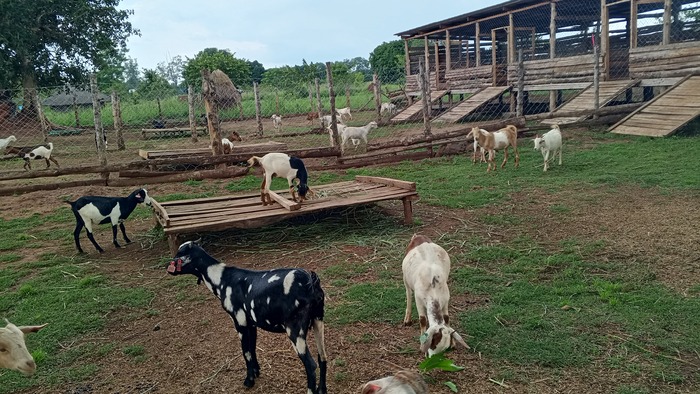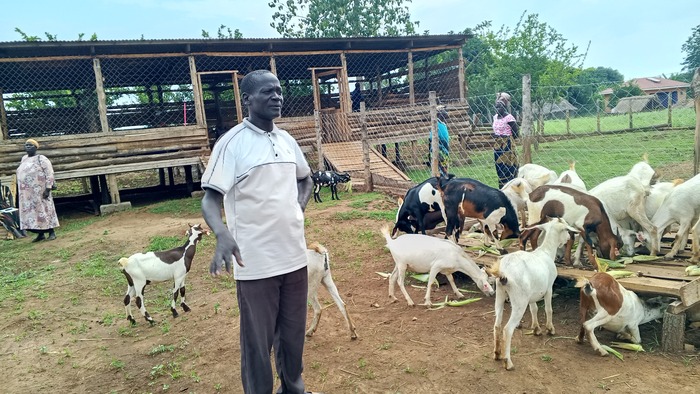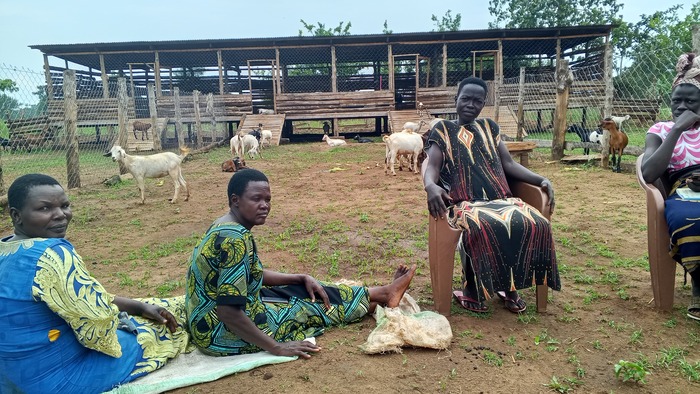By Aciro Gladys Tracy
In the Northern Uganda district of Gulu, rising heat waves and extreme weather events like droughts and floods have significantly impacted on agriculture leading to disruptions in crop yields, livestock productivity, and overall food security.
However Bennaps Business Solution Limited, a farmer group in Lukulia Village, Atiak Town Council in Amuru District is responding to the challenge with a goat raring project.
Bennaps Business Solution Limited has nine (9) members including seven (7) women and two men.
For long the group had been engaged in crop production. But due to the effects of climate change, they had to divert to livestock focusing on goats rearing.
Rearing goats in Uganda is generally easy because most areas have a wide variety of shrubs, scrubby wood and grass.
Poni Esther (37), a member of the group, said she had been engaging in crop production for more than 8 years but reaped not much in terms of yields.
‘’Because of the effects of climate change, I had not been harvesting much every season before I decided to try goat rearing this year” I hope when we start selling them, we will get some money which will change our lives,” says Poni.
They were supported by Palladium, a global leader in the design, development, and delivery of Positive
Impact projects, working with governments, businesses, and investors to address global challenges.
On April 28th, 2025, Palladium supported Bennaps Business Solution Limited with 52 goats (50 females and 2 males) and then UGX.9 million.

The group was asked to register with the Uganda Registration Services Bureau (URSB) and to contribute a start-up capital.
The group had earlier on benefited from the Parish Development Model (PDM) funds (UGX 1M each) and each ably contributed startup capital of UGX 1.3M each.
Through careful breeding strategies, you can create goats that produce more milk, exhibit stronger immunity, and yield better meat or fiber.
Goats breeding is a moneymaker and for farmers and breeders developing a herd of goats with greater genetics is key to achieving higher productivity, better health, and overall resilience.
The Arabian market needs at least 50,000 goats every month from Uganda.
According to estimates by the agriculture ministry, there were around 13.5 million goats in Uganda in 2015.
This was, however, a tremendous growth in numbers from 3.5 million goats in 1990, 5.7 million in 1996 and about 7.6 million in 2002.
About 95% of goats in Uganda are indigenous breeds, while the remaining 5% are crossbreeds or pure exotic goats such as the savannah, toggenberg and boer.
These were imported to improve meat and milk production of the offspring of crossbreeds.
Atoo Madelena (70) is another member. She says for years she had been engaged in crop farming but the outcome wasn’t good.
“This is because most times the crops could be destroyed by either too much sunshine or heavy rain.” She narrates.
According to Atoo, every year she had been spending more than 900,000 shillings every season in crop production despite poor harvests. She had to divert to rearing goats because it’s much easier as compared to crop production.
Challenges
Despite making a decision to start up a goat rearing project in a group, it has also not been easy.
Goats can as well suffer from various diseases, including parasites, respiratory infections, and bacterial infections, which can significantly impact their health and productivity.
These can be caused as a result of bacterial infection and the symptoms can be seen through swollen lymph nodes, fever, and weight loss and pus formation.

Alal Beatrice is the group Secretary. She says despite their efforts, out of the 52 goats received, two died and eight got miscarriages.
Dr. Laban Ochola is the Omoro District Veterinary Officer. He explains the causes of miscarriage in goats and solutions to it.
According to Dr. Ochla, miscarriage in goats occurs in different stages of pregnancy and can be as a result of diseases like Brucellosis, the type of feed given to them or the type of treatment administered to them at that moment.
He asked those rearing and breeding goats to always consult their veterinary Officers early enough so that they advise them on what to do.
Socio-Economic Benefits
Goat breeding is the practice of selectively breeding goats to improve production of fiber, meat, dairy products or goatskin among others.
Goats have important roles in the traditional, cultural, social and economic sectors of the Ugandan small farmer.
The most important role however is the provision of meat. In Uganda, goat meat is ranked second to beef in quantity, but in terms of palatability and delicacy, it is preferred to beef.
Goat’s meat is also a favorite food on special occasions such as the celebration of funeral rites,
Christmas day, Easter day, wedding ceremonies and thanksgiving ceremonies for the birth of a new baby.
Because of its small size, a goat is often slaughtered in honor of a special guest, a visiting relative or a friend.
Best Practices
For farmers and breeders developing a herd of goats with greater genetics is key to achieving higher productivity, better health, and overall resilience.
Through careful breeding strategies, you can create goats that produce more milk, exhibit stronger immunity, and yield better meat or fiber.
Professor Richard Echodu the Director of Gulu University multifunction research laboratory in the
Faculty of Agriculture and Environment adds that “Goats rearing is very easy especially in Northern
Uganda because of the varieties of feeds but the only thing still lacking is proper knowledge and mindset’’
According to Professor Echodu, in order to improve on the quality of our goats, we need to improve on their genetics by practicing crossbreeding, because with this, the females will grow and produce faster.
Goats reach sexual maturity when they start puberty, usually between 4 and 6 months. But to reach their full size, most goats take about two years.
To finish maturing, they’ll need to reach four years old.
Statistics
According to estimates by the agriculture ministry, there were around 13.5 million goats in Uganda in 2015.
This was, however, a tremendous growth in numbers from 3.5 million goats in 1990, 5.7 million in 1996 and about 7.6 million in 2002.
About 95% of goats in Uganda are indigenous breeds, while the remaining 5% are crossbreeds or pure exotic goats such as the savannah, toggenberg and boer.
These were imported to improve meat and milk production of the offspring of crossbreeds.
The Production of this story was supported by InfoNile in Partnership with Palladium under the Climate Smart Jobs.



